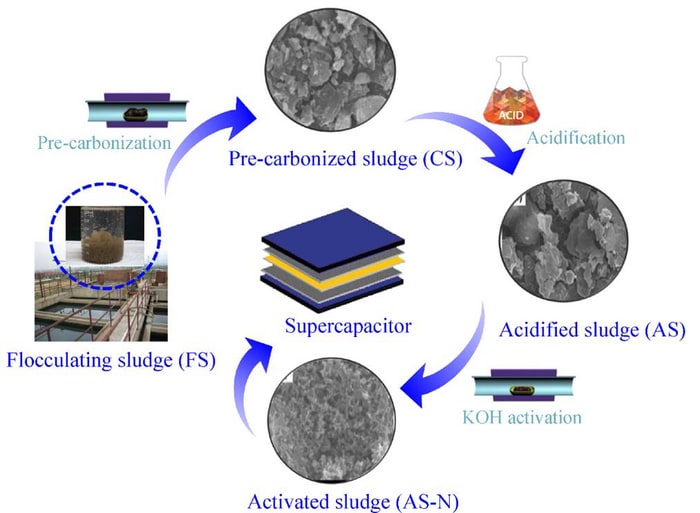
The treatment rate of urban sewage and industrial wastewater has increased year by year, making floc sludge — a type of solid waste produced in such conditions that can serve as a serious environmental and human-health hazard — more prevalent.
That soon may be a good thing, though — at least according to the study “Recovery and reuse of floc sludge for high-performance capacitors” from the Institute of Process Engineering and University of Chinese Academy of Sciences.
Sludge contains a large amount of carbon and metal salts, and much attention has been drawn to their excellent electrochemical properties. Also, the electrochemical properties of carbon materials can be greatly improved by various types of pretreatments — indicating that sludge has good reuse application potential in the electrochemical field.
Many questions remain, however: the feasibility of facile fabrication of capacitors from floc sludge, the effects of different treatment processes on the electrochemical properties of sludge materials, and the environmental impacts such as resource consumption and toxicity risks.
Using acidification and KOH activation at high temperature, researchers transformed floc sludge into porous carbon matrix composites to be used as an electrode material for application in capacitors; compared effects of different treatment processes on the electrochemical properties of sludge materials; and analyzed the environment impacts by life cycle assessment.
The results showed that the pore structure formed via acidification and KOH activation at high temperature. They compared the crack effect of three different acids and chose one of them to investigate the activation influence on the pore structure and electrochemical performance at four mass ratios of KOH/C, the release says.
It also revealed that “the conductivity increased by Fe, the mass transfer efficiency enhanced by more carboxyl functional groups, and new pores created by the KOH activation method produced better properties for electrochemical applications.”
Related Articles
Two Devices for Removing Sludge From Bioreactor Wastewater
Energy-Efficient Sewage Plants
“This study developed a facile, clean, and healthy resource utilization method by reusing floc sludge for carbon matrix electrodes with porous channels and high conductivity,” the release says. “This work not only provides a cost-effective strategy to synthesize hierarchical porous carbon as an electrode material for high-performance supercapacitors but also offers a promising method for the large-scale fabrication of energy storage materials from hazardous industrial waste.”
Q&A with the study’s author, He Zhao, Ph.D/Professor, Institute of Process Engineering, Chinese Academy of Sciences (edited for clarity)
Tech Briefs: What’s the next step?
He Zhao: In this paper, strong acids were used, which led to an 11% increase in carbon emissions. Because of the demand for carbon neutrality, we will next study environmentally friendly materials instead of strong acids to increase the porous properties of oxygen-containing groups of carbonized sludge. Further, efforts will be spent to save the power usage and time required for large-scale fabrication.
Tech Briefs: When will this technology be available for sale?
He Zhao: The stability of this technology needs to be further optimized, which may take three to five years.
Tech Briefs: Will there be a large market for it? Will it catch on?
He Zhao: I think the market is relatively large. Sludge treatment and disposal has always been a difficult challenge for industry. With the rapid and stable development of China’s economy, the scale of urban sewage treatment in China is increasing gradually, and the sludge output is also increasing correspondingly. It is predicted that it will reach more than 80 million tons in these years, but about 15 – 20% of sludge has not been disposed via standardized treatment, which may cause secondary pollution and pose a serious threat to the environment.
Therefore, the problem of sludge disposal is still raised year after year, and how to get through the “last mile” of sewage treatment has become a chronic problem for society. Resource technology will be the direction of sludge treatment in the future for environmental protection and to contribute to the sustainable development of society.
Tech Briefs: How will this change the waste game?
He Zhao: Conventionally, sewage sludge is subject to landfill, incineration, and cropland utilization. However, there is not enough landfill capacity, the transport time for sludge incineration is long, and the cost is high. Hence, many environmental protection enterprises are actively developing sludge resource disposal to find another way out.
Up until now, sludge disposal technology has been in the development stage, and very few technical avenues have been fully popularized and applied. This has led to the lack of sufficient market driving force for sludge disposal. When sludge disposal technology matures, the solid waste disposal market will start to flourish.
Tech Briefs: What are the pros and cons?
He Zhao: The sludge problem has become the bottleneck and shortcoming of environmental protection in some places in China. The market has great potential, but there are still many problems to be solved. Currently, enterprises must pay a third-party treatment fee ranging from 100 yuan ($14.84) to several hundred yuan to treat a ton of sludge, which is costly. In addition, the lack of policy support for the utilization of sludge resources, the lack of coordination mechanisms among various links and departments, and the expansion of the output of sludge treatment products will also be problems to overcome.
Tech Briefs: Working on other such advances?
He Zhao: Our team has carried out research on the reuse of coagulation sludge in wastewater treatment by the electro-Fenton process and achieved good effects. It also provided a practical method of sludge resource utilization. (Resources, Conservation & Recycling 185 (2022) 106475) (Tech Briefs)
 Search
Search




 京公网安备110402500047号
京公网安备110402500047号